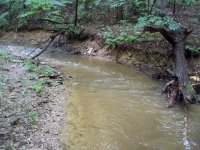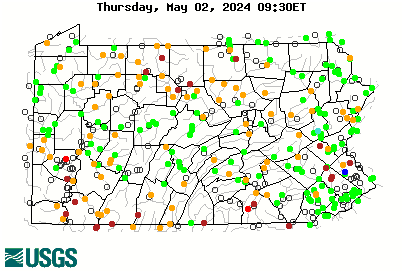PSUFishMenace
Member
- Joined
- Aug 12, 2009
- Messages
- 733
There's been a lot of rain in my area this week and I got out twice to fish for native brookies in the high, muddy water. The first time I only caught one 4" brookie, today I caught 2 nicer ones. I didn't get skunked but with the outstanding days I've had fishing for wild browns in similar conditions, I feel like I should be doing much better. I'll drift or strip a black wooly bugger through the heart of pools that I know hold several trout and won't get a single hit. I tried some other flies too, such as big nymphs and SJ worms, and nearly every pool it's the same story...no bumps from short strikes, no swirls from chasing fish, nothing. So this leaves me with a bunch of questions that I am hoping you guys can help answer:
1. How soon after heavy rain are brook trout feeding the heaviest? Do they go into hiding and wait for normal conditions to return, or do they feed even as the water is rising? Falling water seems to be best for browns, but so far it's no good for brookies.
2. What flies work best in these conditions? Are brook trout (in a stream loaded with minnows) as willing to chase streamers as brown trout?
3. Do you still need to sneak up on pools as if the water was clear?
4. If the high water comes at the end of the summer when the water had been low(normal low summer levels on this particular stream, no worse than any other year), concentrating fish into only the larger pools, how fast will they leave those refuge pools when rains return? Does it take several storms within a few days, or will 4-6 hours of high water be enough to get them to spread out a bit?
5 (the most bizarre thing I could come up with). Do large creek chubs get to feed before the trout? I ask this because I caught some large creek chubs in places I hadn't seen them before, and remember reading online a few years ago that brook trout have been documented to stop eating other fish in the presence of a significant number of creek chubs.
I'm very interested to hear what you guys have to say, appreciate any advice you are willing to share!
Here's a pic I took today to give an idea of the conditions I'm talking about. This was right when I got there, the water was almost back to normal when I left.
1. How soon after heavy rain are brook trout feeding the heaviest? Do they go into hiding and wait for normal conditions to return, or do they feed even as the water is rising? Falling water seems to be best for browns, but so far it's no good for brookies.
2. What flies work best in these conditions? Are brook trout (in a stream loaded with minnows) as willing to chase streamers as brown trout?
3. Do you still need to sneak up on pools as if the water was clear?
4. If the high water comes at the end of the summer when the water had been low(normal low summer levels on this particular stream, no worse than any other year), concentrating fish into only the larger pools, how fast will they leave those refuge pools when rains return? Does it take several storms within a few days, or will 4-6 hours of high water be enough to get them to spread out a bit?
5 (the most bizarre thing I could come up with). Do large creek chubs get to feed before the trout? I ask this because I caught some large creek chubs in places I hadn't seen them before, and remember reading online a few years ago that brook trout have been documented to stop eating other fish in the presence of a significant number of creek chubs.
I'm very interested to hear what you guys have to say, appreciate any advice you are willing to share!
Here's a pic I took today to give an idea of the conditions I'm talking about. This was right when I got there, the water was almost back to normal when I left.





